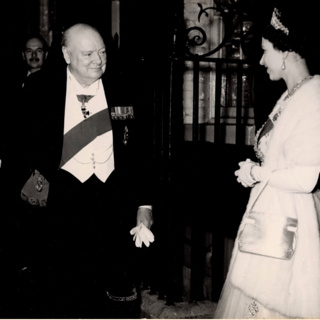
23. An uncertain throne and an oak tree
We start with Charles I's son mounting a throne in Scotland as Charles II, and end with him hiding up an oak tree, throneless once more. In between, lots of exciting battles, all rather boringly won by the same Cromwell with the same army, and the even more thrilling betrayal and execution of the Marquess of Montrose. Betrayed by the 'master fiend Argyll' or perhaps betrayed to Argyll by the very master, Charles II, he sought to serve so faithfully? Illustration: Archibald Campbell, 1st Marquess of Argyll, after David Scougall National Portrait Gallery 3109 Music: Bach Partita #2c by J Bu licensed under an Attribution-NonCommercial-No Derivatives (aka Music Sharing) 3.0 International License
9 Mars 20218min

22. A desert called peace
This is the chapter where we reach the Third English Civil War. We've seen that though their concerns may have been mainly English, the civil wars were by no means limited to England. They were, indeed, wrapped up in the Wars of the Three Kingdoms. So far, I've tended to ignore Ireland a bit, and this episode will put that right. Especially as Cromwell's actions in Ireland are a major element of his career, showing him to be once more a victorious general, but not a particularly humane rules, or even a merciful one. That being said, there's no need to overstate the horrors associated with his campaign in Ireland. There's certainly been exaggeration down the centuries. But, frankly, the truth of what happened in Ireland during Cromwell's campaign is quite horrific enough anyway. In a long history marked by terrible moments, Cromwell's campaign in Ireland was one of the bleakest in the relations between Britain and that long-suffering island. Illustration: Oliver Cromwell by Robert Walker Oil on Canvas, circa 1649 National Portrait Gallery 536 Music: Bach Partita #2c by J Bu licensed under an Attribution-NonCommercial-No Derivatives (aka Music Sharing) 3.0 International License
4 Mars 20218min

21. Round 2 and a deluded king’s fine death
When the Scots began to worry about the increasing power of the New Model Army, and even whether it might be a bigger threat to them than the king, they decided to open negotiations with him. The result was a strange alliance between former enemies. Charles escaped and joined them, launching the Second English Civil War. Which he lost, just like the First. This time, though, his enemies had run out of patience with him. They decided that he had to go. For that, they organised a show trial, but even to get that they first had to pull off a military coup. With all that in place, they got their trial and eventually the execution they wanted. Which Charles went to with courage and dignity, that won him widespread affection again. In fact, he handled his death so well that it seems rather a pity he didn't handle his life as wisely. The illustration is an engraving from Nalson’s Record of the Trial of Charles I. Plate 2 from “A True copy of the journal of the High Court of Justice for the tryal of K. Charles I as it was read in the House of Commons and attested under the hand of Phelps, clerk to that infamous court”, taken by J. Nalson Jan. 4, 1683. Credit: British Museum / Commons. Music: Bach Partita #2c by J Bu licensed under an Attribution-NonCommercial-No Derivatives (aka Music Sharing) 3.0 International License
27 Feb 202111min

20. Interlude
The First Civil War had ended. King Charles I had lost, which wasn't just a military or political problem, but a religious one too: after all, if God had made him king, and God also determined who won wars, who could make sense of what was going on? Had God sided with Parliament against the king he'd set on his throne in the first place. In practical terms, Charles was in captivity, a prisoner of Parliament. In the country at large, normal politics could have restarted, if politics had been anything like normal. There were tensions between Parliament and Parliament's army, which was beginning to do some of its own political soul-searching. Which was particularly interesting, since it was the most powerful organisation in the country. And, within the army itself, there were tensions too, as new trends appeared, among common people, wondering whether, what will all the fighting they were doing, and all the sacrifices they had made, they shouldn't be given a bit more of a say in the running of the state. Fascinating debates. Sadly cut short. Because Charles may have been down, but he wasn't yet out. And he could still do something destructive and self-destructive. The illustration is the front page of one of the versions of the Leveller document, 'An Agreement of the People', laying out demands for wider political rights. Music: Bach Partita #2c by J Bu licensed under an Attribution-NonCommercial-No Derivatives (aka Music Sharing) 3.0 International License
22 Feb 202114min

19. First Civil War: Parliament gets serious
Parliament getting serious about the Civil War, getting its act together on military matters - above all by launching its New Model Army - and starting to win some key battles. Against that context, and helping Parliament on its way to success, there's the meteoric rise of Oliver Cromwell, a man whose military ability hadn't been suspected before. Not that this will be the end of his surprises for England. The episode ends as the First Civil War - ironically referred to as the 'Great Civil War' - also closes with poor old King Charles I in pretty dire straits. General Oliver Cromwell at Marston Moor, 1644 Engraving by William French after Ernest Crofts ARA, published by J S Virtue and Company Limited, London, 1860 (c). National Army Museum. 1999-04-158-1 Music: Bach Partita #2c by J Bu licensed under an Attribution-NonCommercial-No Derivatives (aka Music Sharing) 3.0 International License
17 Feb 20219min

18. First Civil War: the fight gets going
Oh dear, oh dear. Charles I pushed and pushed. Eventually, the other side pushed back. First it was the Scots, who turned out to be a lot better at fighting than Charles had imagined, and gave him a considerable black eye. Then, when he turned to Parliament in London, after eleven years without calling one, far from getting the funds he needed to fight the Scots, he found himself at loggerheads with them too. And then things turned even nastier... The illustration is courtesy of the National Army Museum, and shows 'roundhead' cavalrymen in Moorland. Music: Bach Partita #2c by J Bu licensed under an Attribution-NonCommercial-No Derivatives (aka Music Sharing) 3.0 International License
12 Feb 202113min

17. Things fall apart
Charles I, like his father, proved extremely good at not being at all good at getting on with people he really needed to be really good at getting on side. Just like with his Dad, that mainly meant Parliamentarians. People like John Hampden, one of the great warriors against royal overreach, and a certain Oliver Cromwell who - and I don't think this is a spoiler - would have a pretty big role to play later. There was one big difference between father and son, though: James managed to avoid things getting so bad that they degenerated into actual warfare. Welcome to the threshold of the English Civil Wars. King Charles I, by Gerrit van Honthorst, oil on canvas, 1628 National Portrait Gallery, London, 4444 http://creativecommons.org/licenses/by-nc-nd/3.0/ Music: Bach Partita #2c by J Bu licensed under an Attribution-NonCommercial-No Derivatives (aka Music Sharing) 3.0 International License
7 Feb 202110min

16. Slippery Slope
Charles I started his reign in just the way he'd go on with it, and in just the way his father James I/VI had ended his: by getting right up the noses of most of his subjects in Scotland as well as England, and falling apart big time with the Westminster Parliament. Having failed with one attempt at a marriage with a Catholic Princess from Spain, he just organised himself a different one, with a Catholic Princess from France - Spain's deadliest enemy but just as Papist. He got into disputes with Parliament and Protestants generally about anti-Protestant, or even pro-Catholic action, and with Parliament specifically about taxation, since he could never raise enough for his needs without their authorisation, which he resented. In this neat way, he set up all the pieces for the painful clashes he'd face over the following years. The illustration is a portrait of King Charles I, by Gerrit van Honthorst, oil on canvas, 1628 National Portrait Gallery, London, 4444 The music is Bach Partita #2c by J Bu. Both image and music are licensed under an Attribution-NonCommercial-No Derivatives (aka Music Sharing) 3.0 International License http://creativecommons.org/licenses/by-nc-nd/3.0/
2 Feb 20218min





















